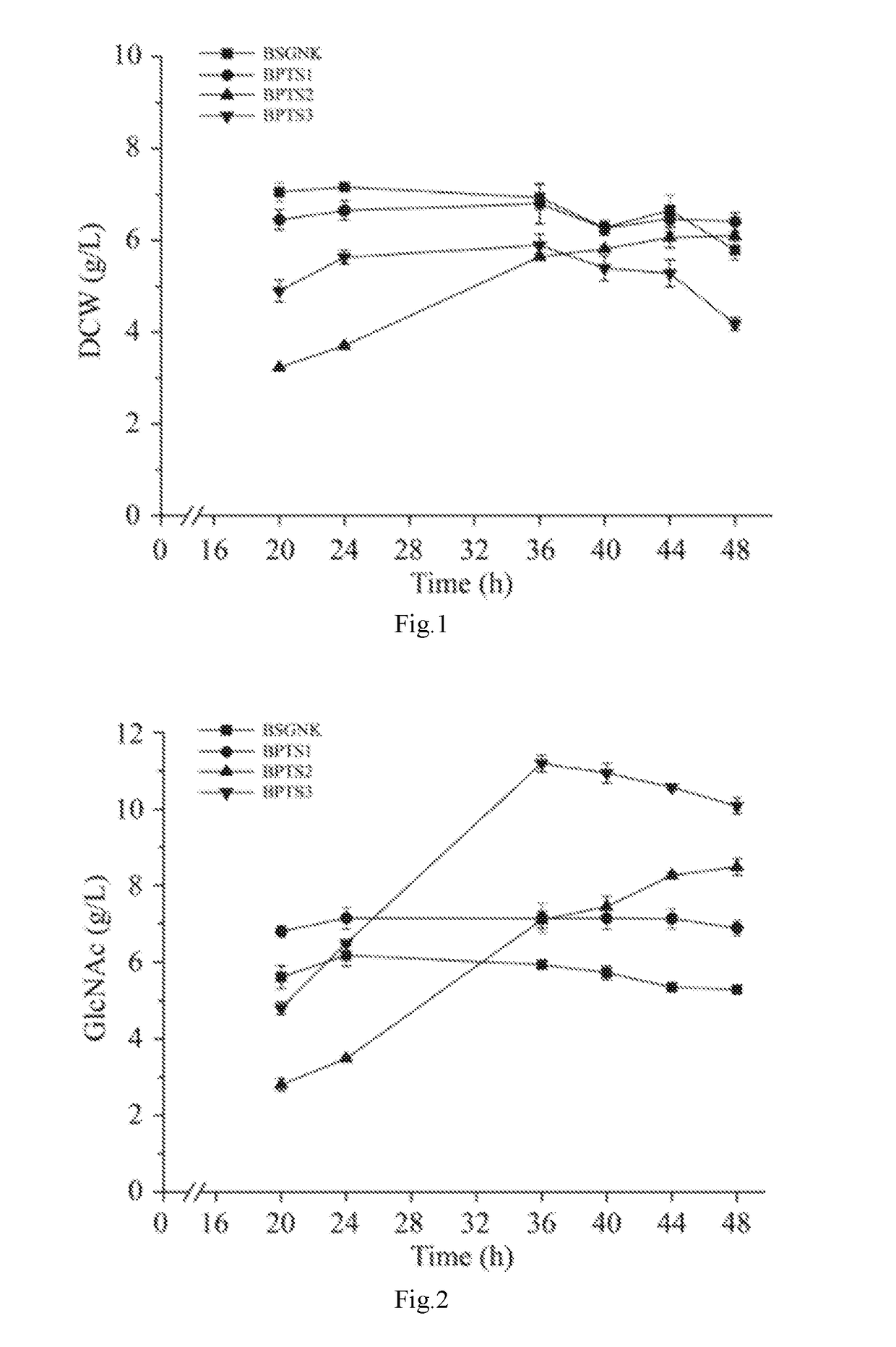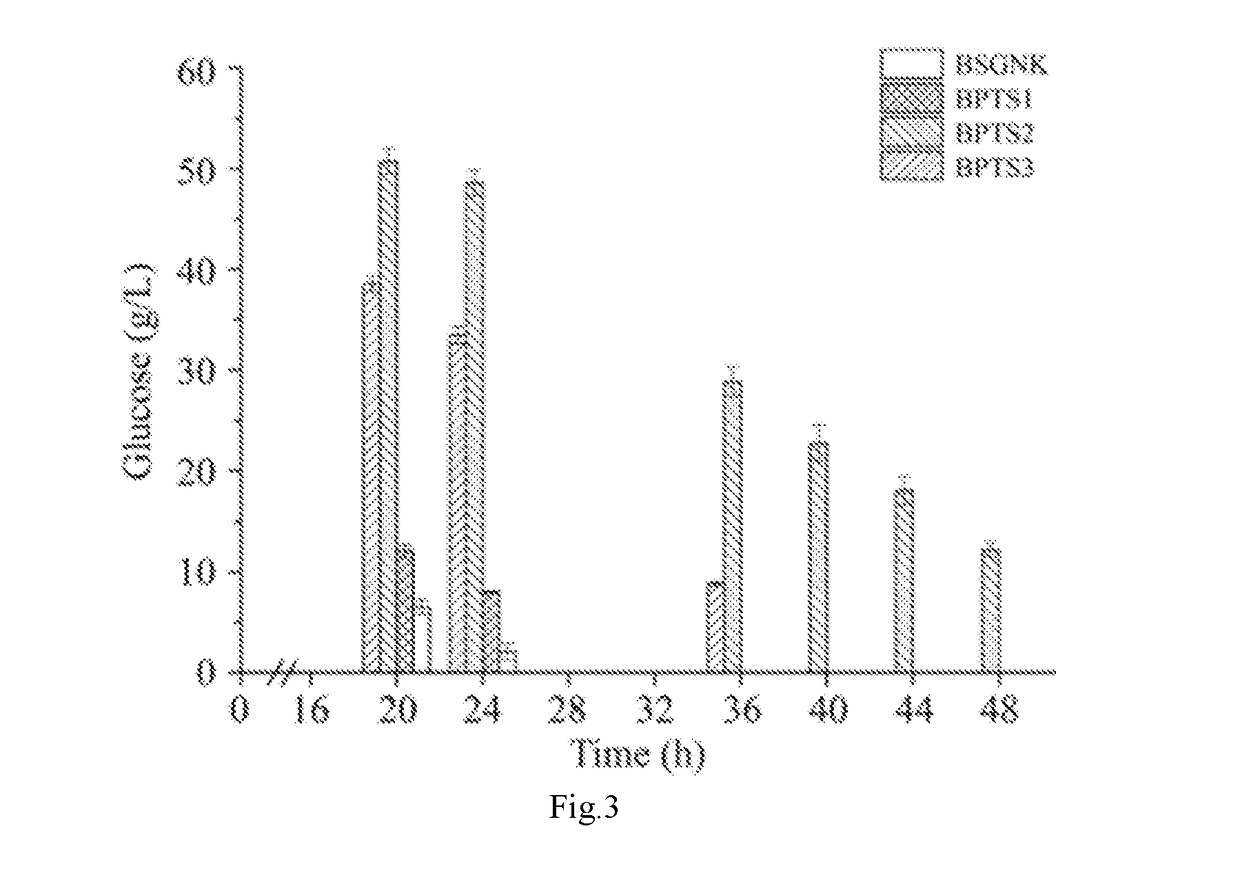Method for Improving GlcNAc Production of Recombinant Bacillus Subtilis
- Summary
- Abstract
- Description
- Claims
- Application Information
AI Technical Summary
Benefits of technology
Problems solved by technology
Method used
Image
Examples
embodiment 1
[0044]Deletion of Phosphoenolpyruvate Carboxykinase Encoding Gene pckA of the Strain BSGNK to Block the Anaplerosis from PEP to Oxaloacetate, to Obtain the Recombinant Strain BPTS1, Wherein BSGNK is Obtained by the Method Disclosed in China Patent Application Ser. No. 201510394205.7.
[0045]Deletion of phosphoenolpyruvate carboxykinase pckA was first performed to block the anaplerosis from PEP to oxaloacetate. Specifically, a primer pckA-F (ACGGACTTCACTTAGGCGGC) / pckA-R (GACGGATTTTTATATTTGCGCG) was used to amplify a pckA disrupt cassette, which included a pckA upstream homology sequence (1 kb), a zeocin resistant gene expression cassette, and a pckA downstream homology sequence (1 kb), from B. subtilis 168. DNA sequence of the pckA disrupt cassette is as shown in SEQ ID NO.1. The amplified pckA disrupt cassette was transformed into the strain BSGNK, and transformants were selected on LB plate with 30 μg / mL zeocin. Positive transformants with pckA gene deletion were further verified by ...
embodiment 2
[0046]Deletion of Pyruvate Kinase Encoding Gene pyK in the Strain BPTS1 to Block the Synthesis from PEP to Pyruvate by Glycolysis Pathway.
[0047]Deletion of pyruvate kinase pyK was performed to block the synthesis from PEP to pyruvate by glycolysis pathway. Specifically, the primer pyK-F (ACGAATAGGGGTATTAACGAGCG) / pyK-R(CAGCTAACAGCAAAGCAATCAGC) was used to amplify a pyK disrupt cassette, which included a pyK upstream homology sequence (1 kb), a zeocin resistant gene expression cassette, and a pyK downstream homology sequence (1 kb), from B. subtilis 168. DNA sequence of the pyK disrupt cassette is as shown in SEQ ID NO.2. The amplified pyk disrupt cassette was transformed into the strain BPTS1, and transformants were selected for on LB plate with 30 μg / mL zeocin. Positive transformants with pyK gene deletion were further verified by colony PCR with primers pyK-F / pyK-R. The vector pTSC was introduced into the Positive transformants to promote the recombination between lox71 and lox66, ...
embodiment 3
[0048]Overexpression of Pyruvate Carboxylase Encoding Gene pycA of the Strain BPTS2 to Facilitate Cell Growth.
[0049]Overexpression of pyruvate carboxylase encoding gene pycA was performed to facilitate cell growth. Specifically, a primer pycA-F (GCAGAGCTGGTTTAAAATCGG) / pycA-R(CCCAAGTTGAAAGCTTAACGAGA) was used to amplify a pycA overexpressed cassette, which included a pycA upstream homology sequence (1 Kb), a zeocin resistant gene expression cassette, a P43 strong promoter, a pycA sequence with replacing the start codon GTG with ATG, from B. subtilis 168. DNA sequence of pycA overexpressed cassette is as shown in SEQ ID NO.3. The amplified pycA overexpressed cassette was transformed into the strain BPTS2, and transformants were selected on LB plate with 30 μg / mL zeocin. Positive transformants with pycA gene overexpression were further verified by colony PCR with primers pycA-F / pycA-R. The vector pTSC was introduced into the positive transformants to promote the recombination between l...
PUM
| Property | Measurement | Unit |
|---|---|---|
| Density | aaaaa | aaaaa |
| Density | aaaaa | aaaaa |
| Density | aaaaa | aaaaa |
Abstract
Description
Claims
Application Information
 Login to View More
Login to View More - R&D
- Intellectual Property
- Life Sciences
- Materials
- Tech Scout
- Unparalleled Data Quality
- Higher Quality Content
- 60% Fewer Hallucinations
Browse by: Latest US Patents, China's latest patents, Technical Efficacy Thesaurus, Application Domain, Technology Topic, Popular Technical Reports.
© 2025 PatSnap. All rights reserved.Legal|Privacy policy|Modern Slavery Act Transparency Statement|Sitemap|About US| Contact US: help@patsnap.com


